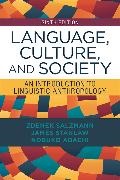Read more
Informationen zum Autor Zdenek Salzmann! a native of Prague! is professor emeritus of anthropology at the University of Massachusetts! Amherst! and adjunct professor at Northern Arizona University. A specialist in Native American languages and folklore! he is the author! with his wife! Joy! of Native Americans of the Southwest.James Stanlaw is professor of anthropology at Illinois State University. His areas of interest include linguistic anthropology! cognitive anthropology! language and culture contact! and Japan and Southeast Asia. He is the author of Japanese English: Language and Culture Contact.Nobuko Adachi is associate professor of anthropology at Illinois State University. Her interests include language and transnationalism! ethnohistory! and ethnic studies. She is the author of Japanese Diasporas: Unsung Pasts! Conflicting Presents! and Uncertain Futures. This introduction to linguistic anthropology includes basic concepts and methods, cognition, sociolinguistics, and expanded coverage of gender, race, and class. Now in its 6th edition, this engaging yet systematic introduction to the anthropology of language ranges broadly from basic concepts and methods to culture, cognition, and sociolinguistics, including expanded discussion of gender, race, and class. Zusammenfassung Since 1993! professors have turned to Language! Culture! and Society for its comprehensive coverage of all critical aspects of linguistic anthropology. The revised and updated sixth edition features:A greatly expanded discussion of the sociocultural context of language! including a new chapter on gender and a thoroughly revised and broadened chapter on race! ethnicity! and classEnd-of-chapter resource manuals and study guides with key terms! questions for discussion! group and individual projects! objective study questions and problems (with answers)! and suggestions for further readingAdditional exercises on phonetics and syntax that reflect contemporary researchSidebars and boxes throughout the book that provide ethnographic detail and illustrate the practical experience of conducting linguistic researchA global perspective and a focus on transnational and multilingual anthropologyExpanded sections on written languages and theoretical and historical perspectives of linguistic anthropology. Chapter 1. Introducing Linguistic Anthropology Chapter 2. Methods of Linguistic Anthropology Chapter 3. "Nuts and Bolts" Linguistic Anthropology I: Language is Sound Chapter 4. "Nuts and Bolts" Linguistic Anthropology II: Structure of Words and Sentences Chapter 5. Communicating Nonverbally Chapter 6. The Development and Evolution of Language: Language Birth, Language Growth, and Language Death Chapter 7. Acquiring Language(s): Life with First Languages, Second Languages, and More Chapter 8. Language through Time Chapter 9. Languages in Variation and Languages in Contact Chapter 10. Ethnography of Communication Chapter 11. Culture as Cognition, Culture as Categorization: Meaning and Language in the Conceptual World Chapter 12. Language, Culture, and Thought Chapter 13. Language, Identity, and Ideology I: Variations in Gender Chapter 14. Language, Identity, and Ideology II: Variations in Class, Race, Ethnicity, and Nationality Chapter 15. Linguistic Anthropology in the Globalized World Glossary Bibliography Languages Mentioned in the Text and Their Locations (map) Index ...

